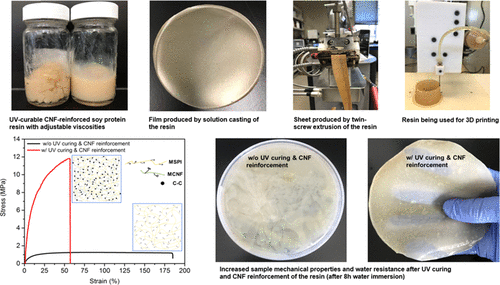当前位置:
X-MOL 学术
›
ACS Appl. Polym. Mater.
›
论文详情
Our official English website, www.x-mol.net, welcomes your feedback! (Note: you will need to create a separate account there.)
UV-Curable Cellulose Nanofiber-Reinforced Soy Protein Resins for 3D Printing and Conventional Molding
ACS Applied Polymer Materials ( IF 5 ) Pub Date : 2020-09-09 , DOI: 10.1021/acsapm.0c00717 Qian Ma 1, 2 , Damian Mohawk 1, 2 , Babak Jahani 1 , Xinnan Wang 1 , Yanlin Chen 1, 2 , Andrew Mahoney 1 , J. Y. Zhu 3 , Long Jiang 1, 2
ACS Applied Polymer Materials ( IF 5 ) Pub Date : 2020-09-09 , DOI: 10.1021/acsapm.0c00717 Qian Ma 1, 2 , Damian Mohawk 1, 2 , Babak Jahani 1 , Xinnan Wang 1 , Yanlin Chen 1, 2 , Andrew Mahoney 1 , J. Y. Zhu 3 , Long Jiang 1, 2
Affiliation

|
Plastic wastes pose a serious threat to the environment and there has been strong interest in developing soy protein isolate (SPI)-based plastics to reduce the use of traditional petroleum-based ones. However, the use of SPI plastics has been hindered due to their inferior mechanical properties and poor water resistance compared with traditional plastics. In this work, SPI plastics with significantly improved mechanical properties and water resistance were developed using UV-curable SPI resin and UV-curable cellulose nanofibers. Three UV-curable materials, i.e., methacrylated SPI (MSPI), methacrylated cellulose nanofibrils (MCNF), and methacrylated cellulose nanocrystals (MCNC), were produced through methacrylation of SPI, CNF, and CNC, respectively. Methacrylation of the materials and UV curing of the resins were confirmed using Fourier-transform infrared spectroscopy. Uniform dispersion of CNC, CNF, MCNC, or MCNF in the resin was confirmed by scanning electron microscopy and X-ray diffraction. The tensile properties and water resistance of the resins were found to improve with increasing curing time and degree of methacrylation. The incorporation of CNC, CNF, MCNC, and MCNF further improved the mechanical and water resistance performance of the resins, with the MCNF leading to the largest improvement. UV curing and the cellulose nanofibers evidently worked synergistically to improve the properties of the resins. This study demonstrated a method and formulations to produce the SPI plastics with exceptional properties. Furthermore, the potential of this resin in 3D printing and conventional plastic molding was demonstrated.
中文翻译:

用于3D打印和常规成型的可紫外线固化的纤维素纳米纤维增强大豆蛋白树脂
塑料废料对环境构成了严重威胁,人们对开发基于大豆分离蛋白(SPI)的塑料以减少传统石油基塑料的使用产生了浓厚的兴趣。但是,由于SPI塑料的机械性能较差,并且与传统塑料相比,其耐水性差,因此阻碍了SPI塑料的使用。在这项工作中,使用紫外线可固化的SPI树脂和紫外线可固化的纤维素纳米纤维开发了具有显着改善的机械性能和耐水性的SPI塑料。分别通过SPI,CNF和CNC的甲基丙烯酸酯化生产了三种紫外线可固化材料,即甲基丙烯酸SPI(MSPI),甲基丙烯酸纤维素纳米原纤维(MCNF)和甲基丙烯酸纤维素纳米晶体(MCNC)。使用傅里叶变换红外光谱法确认了材料的甲基丙烯酸酯化和树脂的UV固化。通过扫描电子显微镜和X射线衍射确认了CNC,CNF,MCNC或MCNF在树脂中的均匀分散。发现树脂的拉伸性能和耐水性随着固化时间和甲基丙烯酸酯化程度的增加而提高。CNC,CNF,MCNC和MCNF的并入进一步改善了树脂的机械性能和耐水性,其中MCNF带来了最大的改进。UV固化和纤维素纳米纤维显然可以协同工作以改善树脂的性能。这项研究证明了生产具有优异性能的SPI塑料的方法和配方。此外,
更新日期:2020-11-13
中文翻译:

用于3D打印和常规成型的可紫外线固化的纤维素纳米纤维增强大豆蛋白树脂
塑料废料对环境构成了严重威胁,人们对开发基于大豆分离蛋白(SPI)的塑料以减少传统石油基塑料的使用产生了浓厚的兴趣。但是,由于SPI塑料的机械性能较差,并且与传统塑料相比,其耐水性差,因此阻碍了SPI塑料的使用。在这项工作中,使用紫外线可固化的SPI树脂和紫外线可固化的纤维素纳米纤维开发了具有显着改善的机械性能和耐水性的SPI塑料。分别通过SPI,CNF和CNC的甲基丙烯酸酯化生产了三种紫外线可固化材料,即甲基丙烯酸SPI(MSPI),甲基丙烯酸纤维素纳米原纤维(MCNF)和甲基丙烯酸纤维素纳米晶体(MCNC)。使用傅里叶变换红外光谱法确认了材料的甲基丙烯酸酯化和树脂的UV固化。通过扫描电子显微镜和X射线衍射确认了CNC,CNF,MCNC或MCNF在树脂中的均匀分散。发现树脂的拉伸性能和耐水性随着固化时间和甲基丙烯酸酯化程度的增加而提高。CNC,CNF,MCNC和MCNF的并入进一步改善了树脂的机械性能和耐水性,其中MCNF带来了最大的改进。UV固化和纤维素纳米纤维显然可以协同工作以改善树脂的性能。这项研究证明了生产具有优异性能的SPI塑料的方法和配方。此外,


























 京公网安备 11010802027423号
京公网安备 11010802027423号